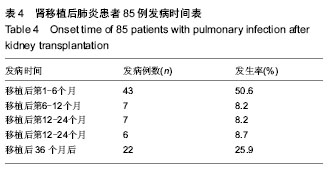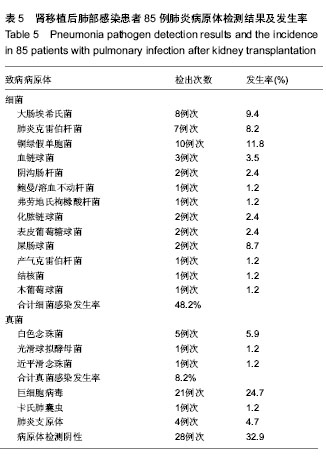中国组织工程研究 ›› 2015, Vol. 19 ›› Issue (2): 262-266.doi: 10.3969/j.issn.2095-4344.2015.02.019
• 组织构建临床实践 clinical practice in tissue construction • 上一篇 下一篇
肾移植后肺部感染治疗中免疫抑制剂的应用
杨其顺,张 琳,张志强,姜 伟,龙 伟,裴向克
- 解放军第281医院肾脏移植中心,河北省秦皇岛市 066100
Immunosuppressant therapy for pulmonary infection after kidney transplantation
Yang Qi-shun, Zhang Lin, Zhang Zhi-qiang, Jiang Wei, Long Wei, Pei Xiang-ke
- Center of Kidney Transplantation, the 281st Hospital of PLA, Qinhuangdao 066100, Hebei Province, China
摘要:
背景:肾移植后肺部感染病情进展快,重症肺炎死亡率高,对其进行早期诊断及治疗具有重要意义,但部分患者因免疫抑制剂的调整,出现移植肾功能受损。 目的:探讨肾移植后肺部感染治疗过程中免疫抑制剂的应用方案。 方法:回顾分析85例肺部感染的肾移植患者的临床资料。肺部感染发生于肾移植后1-6个月43例(其中2-4个月39例),6-12个月7例,12-24个月7例,24-36个月6例,大于36个月22例。根据患者病情,予以调整免疫抑制剂,联合应用小剂量激素抗炎保护移植肾功能,针对病原学抗感染,呼吸衰竭者给予呼吸机辅助呼吸,同时予以降温及营养支持等对症治疗。肺部感染早期减少或停用免疫抑制44例,进展期减少或调整免疫制剂19例,重症肺炎期停用免疫抑制剂5例,肺炎早期及进展期逐步调整免疫抑制15例,肺炎早期减量至重症肺炎停用免疫抑制剂2例。减少或停用免疫抑制剂3-51 d,平均10.7 d。 结果与结论:85例患者中治愈81例,死亡4例。4例死亡病例中,2例死于急性呼吸衰竭,2例死于多器官功能衰竭。治愈的81例中出现急性排异反应3例,移植肾功能受损6例。结果提示,肾移植后肺部感染短时间减少或停用免疫抑制剂,有利于提高治愈率,减少死亡率,及时恢复免疫制剂的应用,能有效保护移植肾功能,尤其是移植肾功能不全患者,肺部炎症进展控制住,及时恢复免疫抑制,在保护移植肾功能的意义更大。
中图分类号:


.jpg)